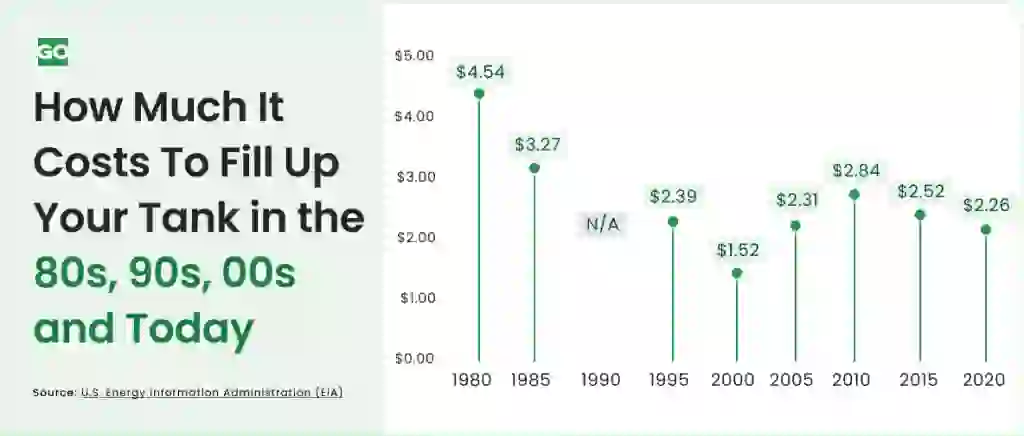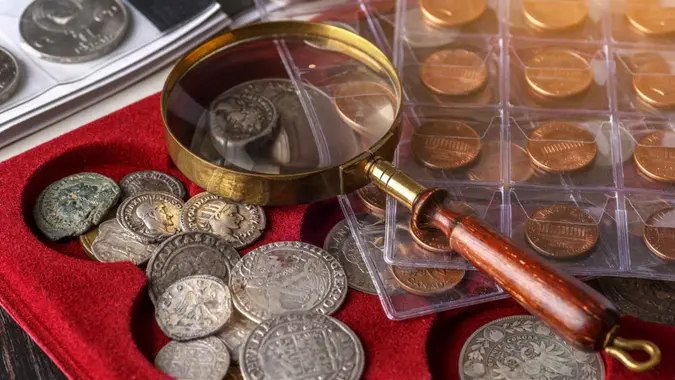The Cost To Fill Up Your Tank in the 1980s, ’90s, ’00s and Today

Commitment to Our Readers
GOBankingRates' editorial team is committed to bringing you unbiased reviews and information. We use data-driven methodologies to evaluate financial products and services - our reviews and ratings are not influenced by advertisers. You can read more about our editorial guidelines and our products and services review methodology.

20 Years
Helping You Live Richer

Reviewed
by Experts

Trusted by
Millions of Readers
The national average price of gas per gallon was $1.19 in 1980. In July 2024, the price of gas across all fuel grades is $3.60.
This might seem like a massive increase, but $1.19 in 1980 would be worth roughly $4.54 in today’s dollars. What this means is that the cost of fuel was actually more expensive — comparatively — than it is today.
That doesn’t mean filling up at the tank is cheap. Prices fluctuate based on a number of factors, including the type of car you have and the fuel grade you choose. Regular gas, for example, tends to be much cheaper than premium fuel.
Factors beyond your control also influence gas prices.
“Gas prices are rising due to factors like supply chain issues and global conflicts, that’s why the idea that gas stations are making big profits is a myth,” said David Poulnot, VP of multi-vertical aales at Upside, the largest fuel app in the U.S. “Most are small businesses struggling with razor-thin margins, just trying to stay afloat in a volatile market.”
So, how much does it cost to fill up your tank now versus in the past? And what can you do to combat prices? Here’s what you need to know.



What It Costs To Fill Up Your Tank Today
The cost of filling up your tank depends on two main factors: Your tank size and the type of fuel you get. Prices can also vary widely depending on where you live in the country.
That said, these are the national average gas prices (per gallon) as of August 2024, according to AAA.
- Regular: $3.387
- Mid-grade: $3.853
- Premium: $4.203
- Diesel: $3.728
- E85: $2.814
J.D. Power reported that the average car holds between 12 and 15 gallons. Assuming you have a larger tank (15 gallons), it’s on empty, and you get the average cost of fuel, here’s what it’ll cost to fill up your tank today.
- Regular: $50.81
- Mid-grade: $57.80
- Premium: $63.05
- Diesel: $55.92
- E85: $42.21
Cost of Filling Up Your Tank in the 2000s and 2010s
The U.S. Energy Information Administration (EIA) put out data regarding the cost of fuel from the early 1990s to today. The data included the price of gasoline across all fuel grades. Here’s an overall breakdown of what a gallon of fuel cost in the 2000s.
- 2000 — $1.523
- 2001 — $1.460
- 2002 — $1.386
- 2003 — $1.603
- 2004 — $1.895
- 2005 — $2.314
- 2006 — $2.618
- 2007 — $2.843
- 2008 — $3.299
- 2009 — $2.406
And here’s what fuel cost in the 2010s (all grades).
- 2010 — $2.835
- 2011 — $3.576
- 2012 — $3.680
- 2013 — $3.575
- 2014 — $3.437
- 2015 — $2.520
- 2016 — $2.250
- 2017 — $2.528
- 2018 — $2.813
- 2019 — $2.691
- 2020 — $2.258
Again, these are per-gallon prices using each respective year’s dollar. With inflation, costs are going to be a little higher in each year — and higher still the further back you go.
- $2.835 in 2010 would be worth $4.09 today.
- $2.258 in 2020 would be $2.74 today.
In terms of the cost of filling up a tank, it depends on your tank size. Using the averages, here’s an overview of what a 15-gallon tank would cost using that time’s dollars (based on every five years from 2000 to 2020).
- 2000 — $22.85
- 2005 — $34.71
- 2010 — $42.53
- 2015 — $37.80
- 2020 — $33.87
Cost of Filling Up Your Tank in the 1990s
The EIA also provides data about the average cost of fuel in the U.S. — all grades — in the 1990s.
- 1990 — N/A
- 1991 — N/A
- 1992 — N/A
- 1993 — N/A
- 1994 — $1.078 ($2.29 in today’s dollars) or $16.17 for a 15-gallon tank
- 1995 — $1.158 ($2.39 in today’s dollars) or $17.37 for a 15-gallon tank
- 1996 — $1.245 ($2.50 in today’s dollars) or $18.68 for a 15-gallon tank
- 1997 — $1.244 ($2.44 in today’s dollars) or $18.66 for a 15-gallon tank
- 1998 — $1.072 ($2.07 in today’s dollars) or $16.08 for a 15-gallon tank
- 1999 — $1.176 ($2.22 in today’s dollars) or $17.64 for a 15-gallon tank
Cost of Filling Up Your Tank in the 1980s
While the EIA didn’t have data going back to the 1980s, another source did. These are the national average gas prices of the 1980s (per gallon) and how much it would have cost to fill up with a tank of gas at the time.
- 1980 — $1.19 ($4.54 in today’s dollars) or $17.85 for a 15-gallon tank
- 1981 — $1.31 ($4.53 in today’s dollars) or $19.65 for a 15-gallon tank
- 1982 — $1.22 ($3.98 in today’s dollars) or $18.30 for a 15-gallon tank
- 1983 — $1.16 ($3.66 in today’s dollars) or $17.40 for a 15-gallon tank
- 1984 — $1.13 ($3.42 in today’s dollars) or $16.95 for a 15-gallon tank
- 1985 — $1.12 ($3.27 in today’s dollars) or $16.80 for a 15-gallon tank
- 1986 — $0.86 ($2.47 in today’s dollars) or $12.90 for a 15-gallon tank
- 1987 — $0.90 ($2.49 in today’s dollars) or $13.50 for a 15-gallon tank
- 1988 — $0.90 ($2.39 in today’s dollars) or $13.50 for a 15-gallon tank
- 1989 — $1.00 ($2.54 in today’s dollars) or $15.00 for a 15-gallon tank
Ways To Save Money at the Pump
No matter what size tank you have, it never hurts to find ways to save money when filling up. Here are just a few strategies, according to experts.
- Use loyalty programs. “Consider signing up for gas station loyalty programs and using cash back apps to make your dollar go further,” Poulnot said. “Upside, for example, offers up to 25¢/gal and 22% cash back at over 30,000 gas stations.”
- Plan ahead when driving. “While driving to events, the grocery store, or even work may be the most convenient option, you can save money on gas by opting to walk, bike or take public transit to get to certain destinations if the weather permits,” said Mary Hines Droesch, head of product for consumer, business and wealth management banking and lending at Bank of America.
- Adjust your budget. “When gas prices increase, it’s important to readjust your budget accordingly,” Droesch said. “Check previous receipts or track your spending during the week to see how much money you’re spending on gas. From there, your weekly spend can help you calculate approximate monthly spend.”
- Go to different gas stations. “With a bit of planning and foresight, you can potentially route to gas stations where gas prices tend to be lower — such as further away from major highways,” said Renee Horne, chief marketing and customer experience officer at Chase Auto.
- Don’t fill up all the way. “Instead of filling up all the way, consider just topping up enough gas to safely get you to the next station, where prices are hopefully more affordable,” Horne suggested.
- Lighten your load. “The more weight your car is hauling, the harder it has to work. In turn, that burns more gas,” Horne said. “Some things are necessary, but if there’s any extra weight in the car that you don’t need, removing it could boost your fuel economy.”
 Written by
Written by  Edited by
Edited by 

























